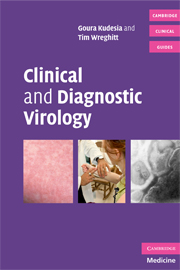Book contents
- Frontmatter
- Contents
- List of plates
- Preface
- Acknowledgements
- SECTION 1 INDIVIDUAL VIRUSES
- SECTION 2 OTHER RELATED AGENTS
- 29 Chlamydia
- 30 Toxoplasma gondii
- 31 Transmissible spongiform encephalopathies (CJD and vCJD)
- SECTION 3 CLINICAL SYNDROMES
- SECTION 4 DIAGNOSTIC TECHNIQUES
- SECTION 5 PATIENT MANAGEMENT
- Index
- Plate section
31 - Transmissible spongiform encephalopathies (CJD and vCJD)
Published online by Cambridge University Press: 07 December 2009
- Frontmatter
- Contents
- List of plates
- Preface
- Acknowledgements
- SECTION 1 INDIVIDUAL VIRUSES
- SECTION 2 OTHER RELATED AGENTS
- 29 Chlamydia
- 30 Toxoplasma gondii
- 31 Transmissible spongiform encephalopathies (CJD and vCJD)
- SECTION 3 CLINICAL SYNDROMES
- SECTION 4 DIAGNOSTIC TECHNIQUES
- SECTION 5 PATIENT MANAGEMENT
- Index
- Plate section
Summary
Transmissible spongiform encephalopathies (TSE) are a group of agents that give rise to spongiform degeneration in the brain. These agents do not possess any nucleic acid (DNA or RNA) and are very resistant to inactivation. They consist of only a glycoprotein core and the term prion or prion protein (PrP) has been coined to describe them. They infect both humans and animals, and have recently been shown to cross the species barrier, e.g. vCJD crossed into humans from cattle. See Table 31.1.
Epidemiology
The first agent to be described was scrapie. Scrapie has been known to cause infection in sheep in the UK for more than a hundred years. In the late 1980s and 1990s there was an outbreak of a bovine form of scrapie, namely bovine spongiform encephalopathy (BSE), which had previously not been described. This led to destruction of thousands of cattle in the UK and a public health crisis in the confidence of beef for human consumption.
Creutzfeldt–Jakob disease (CJD) is the human form of prion disease, and has been known to occur throughout the world since 1920. Kuru is the name given to the infection that was limited to only parts of Papua New Guinea. In the 1990s, a new form of CJD was described for the first time in the UK as a result of BSE transmission; this was named as variant CJD (vCJD) to distinguish it from the already existing CJD.
Human prion disease can be acquired through either an inherited or an infectious route.
- Type
- Chapter
- Information
- Clinical and Diagnostic Virology , pp. 129 - 132Publisher: Cambridge University PressPrint publication year: 2009



